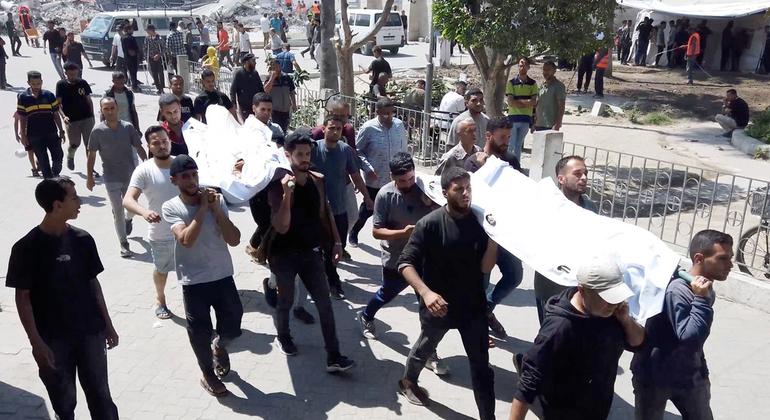I’ve just returned to my Brussels office after a two-week assignment in Gaza, where the scale of human suffering has reached catastrophic proportions rarely seen in my twenty years covering conflict zones. The metrics of this crisis have become increasingly grim, with malnutrition-related deaths now claiming more lives than direct combat casualties in certain areas.
“I’ve buried two children this month,” Samir al-Hadidi told me as we stood outside a makeshift clinic in Deir al-Balah. “Not from bombs, but because their bodies simply gave up.” Al-Hadidi, a former agricultural engineer, now coordinates food distribution for his extended family of seventeen people. “We receive perhaps 30% of what’s needed to survive.”
The United Nations Office for the Coordination of Humanitarian Affairs (OCHA) released its most alarming assessment yesterday, documenting that approximately 85% of Gaza’s remaining population now faces acute food insecurity. This represents the highest percentage recorded in any global crisis since the current measurement systems were established.
Dr. Fatima Khalidi, a nutrition specialist with Médecins Sans Frontières, explained the cascading health impacts. “What we’re witnessing is a collapse of basic metabolic functions. Children arrive with multiple nutrient deficiencies simultaneously—protein, iron, vitamin A—making treatment exponentially more complex.” The medical facility where we spoke treats over 200 severe malnutrition cases daily, operating with just 40% of necessary therapeutic supplies.
The World Food Programme’s regional director Ibrahim Suleiman described to me a system at breaking point. “We’ve exhausted emergency protocols that normally prevent famine conditions. The combination of destroyed infrastructure, restricted access, and depleted local food stocks has created a perfect storm.” According to WFP data, the average Gazan now consumes fewer than 1,100 calories daily, well below the 2,100 minimum standard for human survival.
The current situation stems from a complex interplay of factors. While humanitarian aid deliveries have technically increased by 15% since January, the destruction of 76% of local food production capacity means Gaza has become almost entirely dependent on external assistance. Simultaneously, internal distribution networks have collapsed in many areas, creating what aid workers describe as “famine pockets” where entire neighborhoods receive minimal sustenance.
What makes this crisis particularly severe is its urban nature. Unlike rural famines where populations can sometimes forage or rely on traditional coping mechanisms, Gaza’s densely populated urban environment offers few alternatives when formal food systems fail.
“We’re seeing survival strategies that indicate extreme desperation,” explained Dr. Marwan Bashir, who runs a pediatric clinic in Khan Younis. “Families are boiling tree bark to create a broth that provides minimal calories but almost no nutrition.” Bashir showed me medical records documenting a 310% increase in kwashiorkor cases—severe protein malnutrition that causes distinctive swelling—among children under five.
The economic dimensions of this crisis are equally devastating. The UN Development Programme estimates that 92% of Gaza’s population now lives below the poverty line, with household purchasing power reduced by over 80% compared to pre-conflict levels. This economic collapse has transformed once middle-class families into aid recipients overnight.
I met Nadia Shurrab, a former university professor, queuing for food parcels in a distribution center established in what was previously a commercial mall. “Six months ago, I was teaching international economics,” she said. “Now I spend seven hours daily searching for basic food to keep my family alive.”
The International Committee of the Red Cross has documented a disturbing new trend: food-related violence. “We’re witnessing increasing incidents where desperate individuals attack aid convoys or distribution points,” said ICRC representative Thomas Reichmann. These security challenges further complicate humanitarian operations in an already complex environment.
What distinguishes this hunger crisis from others I’ve covered in Sudan or Yemen is the speed of deterioration. Specialized agencies note that Gaza’s population had relatively good nutritional baselines before the conflict, meaning the precipitous decline represents an unusually rapid health emergency rather than a chronic condition.
Most troubling are the projections. The Famine Early Warning Systems Network (FEWS NET) analysis suggests that without immediate intervention, approximately 40% of Gaza’s children under five could face life-threatening malnutrition within two months. “We’re approaching a point of no return for an entire generation,” warned UN Special Rapporteur on the Right to Food, Dr. Helena Ramirez.
Diplomatic efforts to address the crisis face significant hurdles. While an international donor conference last month pledged $2.4 billion for Gaza humanitarian relief, aid workers on the ground report that bureaucratic obstacles and security constraints continue to prevent effective distribution. An aid worker who requested anonymity told me, “The gap between what’s pledged internationally and what reaches people’s mouths grows wider each week.”
The World Health Organization has deployed additional emergency nutrition teams, but their capacity remains limited without secure humanitarian corridors and functional distribution systems. “We’re treating symptoms of a crisis that requires political solutions,” said WHO emergency coordinator Dr. James Henderson.
As I prepare to file this report, I received a message from al-Hadidi: his nephew’s six-month-old daughter died overnight from complications related to malnutrition. Her name was Leila. She represents the human cost behind the statistics that can too easily numb us to this unfolding catastrophe.






